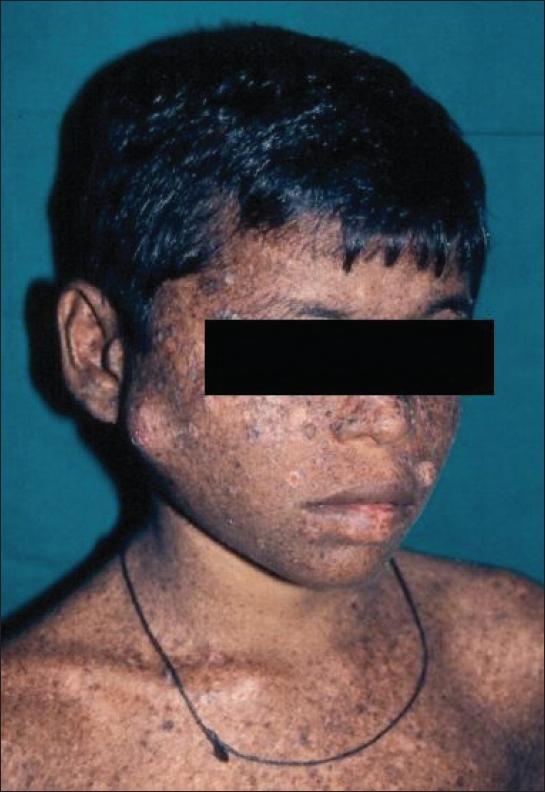Translate this page into:
Pilomatricoma in a case of familial xeroderma pigmentosum
2 Department of Dermatology, Rajiv Gandhi Medical College and Chhatrapati Shivaji Maharaj Hospital Kalwa, Thane, India
Correspondence Address:
Meenal R Patil
Bungalow No. 1, Palacio, Siddeshwar Gardens, Kolshet Road, Thane (West) - 400 607
India
| How to cite this article: Patil MR, Vishwanath V, Arya M, Shenoy B P, Bharmal R N, Torsekar R G. Pilomatricoma in a case of familial xeroderma pigmentosum. Indian J Dermatol Venereol Leprol 2007;73:198-199 |
 |
| Figure 1: A preauricular and a lip nodule |
 |
| Figure 1: A preauricular and a lip nodule |
Sir,
Xeroderma pigmentosum (XP) is a genodermatosis characterized by pigmentary abnormalities, solar skin damage and cutaneous malignancies in the sun-exposed areas. [1] The various skin tumors seen in XP include basal and squamous cell carcinomas, malignant melanomas and less commonly keratoacanthomas, angiomas, fibromas and sarcomas. Pilomatricoma is a benign neoplasm with differentiation towards the hair matrix and has not yet been reported in association with XP. We report this case for such an occurrence.
A 13-year-old boy, a known case of familial XP presented with two nodular swellings, one on the right preauricular area measuring 3.5 cm and the other near the upper lip measuring 1.5 cm, both of five months duration [Figure - 1]. They were skin-colored, rounded nodules, firm in consistency and showed no overlying skin changes. There was no lymphadenopathy. Both lesions were excised and sent for histopathological study.
Gross examination of both nodules revealed a grey white cut surface. Microscopic examination of the preauricular swelling showed masses of epithelial cells with two cell types: basophilic cells at the periphery of cell islands and eosinophilic shadow cells towards the centre. Intervening stroma showed foreign body giant cells. A diagnosis of pilomatricoma was made based on these findings. Histopathological examination of the lip nodule showed features of well-differentiated squamous cell carcinoma.
The patient was one of the three affected siblings, born of a second degree consanguineous marriage in a family with four children. While the eldest sister was unaffected, the patient′s second sister and a younger brother were similarly afflicted by the disease. Subsequently on a four-year follow-up, the patient developed multiple cutaneous tumors on the face simultaneously, which included a conjunctival squamous cell carcinoma, a pigmented basal cell epithelioma on the nose and a malignant melanoma on infraorbital area. The brother too, had developed multiple cutaneous malignancies and died at the age of 15 years, due to the spread of the tumors.
Blood samples of the patient and his sister were sent for chromosomal analysis and 72h stimulated culture-GTG banding with BrdU with controlled match blood sample was performed. While it revealed an increase in sister chromatid exchanges (8-11) in the patient, the number of sister chromatid exchanges in the affected sister were similar to that of the control sample. The patient succumbed to the metastasis of cutaneous malignancies at the age of 17 years. The sister has, as yet, not developed any tumors and has been put on isotretinoin prophylaxis.
Pilomatricoma is a benign pilar tumor with characteristic histology and 60% cases develop in the first two decades of life on head, neck and upper extremities. [2] Its association with xeroderma pigmentosum is hitherto unreported. Whether such an occurrence in our patient is coincidental or an unusual tumor manifestation in XP remains an unanswered question.
Xeroderma pigmentosum is a rare autosomal recessively inherited disorder affecting one in 2,50,000 population. [3] It shows genetic heterogeneity with at least ten different complementation groups identified which have different clinical presentations. [2] Simultaneous occurrence of multiple cutaneous malignancies is common in XP. [4] Nash and Kaelbling have described chromosomal breakages with increase in the number of sister chromatid exchanges in patients of XP and a 1000-fold increased risk of skin cancers. [5] Our patient showed similar chromosomal aberrations which correlated well with his tendency to harbor multiple tumors while his sister who did not show increased number of sister chromatid exchanges has not yet developed cutaneous tumors. Increased mortality in XP from metastatic malignant melanoma and squamous cell carcinoma has been described by Horenstein and Diwan et al . [3] Mortality can be reduced by the use of isotretinoin chemoprophylaxis which prevents further development of squamous cell carcinomas. A recent clinical trial by Yarosh et al used the microbial enzyme T4 endonuclease V applied regularly as a topical liposome lotion. [6] Long-term use of this topical agent significantly reduced the onset of both new basal cell carcinomas and actinic keratoses, thus offering a ray of hope in this disease, which leaves behind intense psychological trauma and poses social and economic problems in the affected families.
Acknowledgment
We acknowledge Mr. Rajesh Patil and Dr. Sandeep Ambekar for the technical assistance provided.
| 1. |
Robbins JH, Kraemer KH, Lutzner MA, Festoff BW, Coon HG. Xeroderma pigmentosum. An inherited disease with sun sensitivity, multiple cutaneous neoplasms and abnormal DNA repair. Ann Intern Med 1974;80:221-48.
[Google Scholar]
|
| 2. |
Strutton G, Stenn KS. Tumours of cutaneous appendages. In : Symmers W. St C, Weedon D, editors. Systemic Pathology. The Skin. 1 st ed. Churchill Livingstone; 1992. p. 827-8.
[Google Scholar]
|
| 3. |
Horenstein MG, Diwan AH. Xeroderma pigmentosum. [Last updated on 2005 June 8]. Available from: http://www.emedicine.com/DERM/topic462.htm. [Last accessed on 2007 February 12]
[Google Scholar]
|
| 4. |
Mohanty P, Mohanty L, Devi BP. Multiple cutaneous malignancies in Xeroderma pigmentosum. Indian J Dermatol Venereol Leprol 2001;67:96-7.
[Google Scholar]
|
| 5. |
Nash D, Kaelbling M. Chromosomal breakage syndromes. [Last updated on 2003 June 19]. Available from: http://www.emedicine.com/PED/topic2862.htm. [Last accessed on 2007 February 12]
[Google Scholar]
|
| 6. |
Yarosh D, Klein J, O'Connor A, Hawk J, Rafal E, Wolf P. Effect of topically applied T4 endonuclease V in liposomes on skin cancer in Xeroderma pigmentosum: A randomized study. Xeroderma Pigmentosum Study Group. Lancet 2001;357:926-9.
[Google Scholar]
|
Fulltext Views
2,626
PDF downloads
1,312





